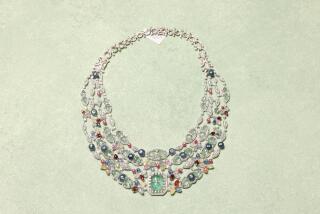‘The City of Diamonds’ Is a Gem
- Share via
Amsterdam is a gem for shopping. Among its most brilliant facets: diamonds. This year, Amsterdam marks the 400th anniversary of its diamond industry with the “City of Diamonds” celebration, a series of special events including several diamond giveaways.
A lovely memorial sculpture, Joost van Santen’s “A Diamant,” on exhibit in a park near the Leidesplein, is a modernistic, pentagonal pyramid of steel. The points open at the top to reveal a sparkling, multicolored interior of armor-plated glass. It’s an exceptional symbol for this city’s exceptional industry.
Diamonds are a good buy in Amsterdam, one of the world’s five top diamond markets. (The others are Antwerp, New York, Tel Aviv and Bombay.) In Amsterdam, the stones are also tax-free. If bought and transported loose, they’re also US. duty-free. Even so, they are expensive, and, as with all luxury items, should be purchased with caution. Best to buy from a well-known, reputable dealer. That way, you’re sure to get what you’re paying for.
Factory Tours
One should also know the basics about diamonds. Amsterdam’s best dealers offer brochures and factory tours as primers on the gems. A diamond’s value depends upon four factors: clarity (the number and nature of internal flaws), color (ranging from exceptional blue-white to a tinted, slightly yellow or brown color), carat (the weight, a carat equals .2 grams, also called 100 points) and cut (the shape, proportion and number of facets). The most popular cut is the brilliant, a sparkling round shape with 58 facets.
Reputable dealers give you a certificate with your diamond, specifying weight, clarity, color and cut. If there is any question about the accuracy of this certificate, don’t buy the stone.
The name Bonebakker & Zoon occasions nods of recognition among those who know diamonds. Located at Rokin 86-90, the company is one of Amsterdam’s oldest, most reputable diamond firms. It was founded by the Bonebakker family in 1792 and was family-run until 1979, when it was purchased by a London-based firm. There has been no change of policy. Bonebakker’s managing director, M. C. Denh Boer, says that the company’s substantial stock of gems is valuable, but its most precious possession is its good name. The company emphasizes personal contact and excellent service, and would rather under-price a diamond than be accused of bilking a client. Bonebakker encourages repeat business and has an impressive list of long-lasting clients, including Holland’s royal family. Bonebakker designed and made the royal crown for William II of Orange in 1840. The client list also includes celebrities, but the firm is too discreet to reel off their names.
Showroom Setting
Bonebakker’s diamonds, colored gems and gleaming gold sparkle in a conservative showroom setting. Gray walls and rug give an impression of luxury, rather than austerity. Lavish jewels and best-brand watches offer temptation through clean glass cases. The attentive salespeople are elegant, unobtrusive, garbed in black.
Bonebakker sells loose and set gems, will recut or reset your old stones, clean your jewelry. Their least expensive ring sells for about $180. It is a wee fraction of a carat, sparkling in 18-carat gold, catching the light and reflecting it, slightly blue, off every perfect facet. An exquisite, tastefully set small stone.
The price range for loose .25-carat stones varies from about $300 to $1,100, depending on cut and quality; larger stones have a broader price range, with a one-carat brilliant ranging from $2,500 to $11,000. A fine 5.03-carat diamond sells for about $41,000.
The heavier stones are sold loose, then set to the buyer’s taste. One stunning ready-made piece is a heavy chain bracelet, designed by Henk de Jager, a cutter with Bonebakker for about 30 years. The bracelet has 11 carats of diamonds set in 160 grams of 18-carat gold. Stunning but not ostentatious. It sells for $15,000. And you can watch De Jager at work in a small atelier adjacent to the Bonebakker showroom.
Amsterdam’s largest diamond factory is Van Moppes & Zoon at Albert Cuypstraat 2-6 (take the 16 tram from Central Station). The firm was founded in 1828 and has been in the Van Moppes family for generations. Arnold van Moppes is director. The company specializes in quality diamonds at volume prices. About 17,000 people tour the factory each year in groups of up to 500. Beginning with a short film, the tour is understandable, detailed enough to provide necessary information for an intelligent purchase. You’ll see rough diamonds sawed, cut, and polished into brilliant gems. You’ll also see the world’s smallest diamond; to the naked eye it look like a speck of dust, but a microscope reveals a multifaceted brilliant.
During the summer, Van Moppes runs two showrooms to handle sales. Diamonds are encased according to size and setting. Overhead signs indicate price range. The cheapest ring (about $100) is a .02 carat stone set in 18-carat gold. Sold loose, the price range for a .25 brilliant (only two high-grade qualities sold) is $900 to $1,200. One-carat stones (from low to very high quality) cost $1,500 to $15,000. The firm will set loose stones, but will not, in general, recut old stones.
Low prices are an inherent part of the Van Moppes policy, reflected at the factory and five Amsterdam boutiques. Van Moppes celebrates the City of Diamonds anniversary by awarding their 10,000th customer this year a diamond worth 1,000 Dutch guilders (about $2,600).
Four more of Amsterdam’s top diamond dealers will offer similar giveaways. They are: Samuel Gassan Diamonds at Nieuwe Achtergracht 17-23; Coster Diamonds at Paulus Potterstraat 2-4; Holshuijsen-Stoeltie at Wagenstraat 13-17, and Amsterdam Diamond Center Rokin 1-5, on the corner of Dam Square.
At the Amsterdam Diamond Center, a .25-carat stone ranges in price from about $390 to $950. One-carat stones range from $2,050 to $17,200. Gems are not cut at the Diamond Center, but you can watch a polisher on the premises. And loose diamonds can be set in a matter of minutes.
Investment Advice
Aside from prestige, beauty and sentimental value, are diamonds a good investment? Opinion varies widely, especially at a time when the market may be influenced by current affairs. Of the diamonds marketed as gemstones (not for industrial use), the largest percentage comes from South African mines. If the political situation there disrupts mining or if economic sanctions against South Africa are enforced, how will the diamond market be affected? Arnold van Moppes says he does not anticipate a big change because the diamond market is largely controlled by the De Beers Co., which both mines and trades. Stones are available to De Beers from diamond producers other than South Africa, where the company mines its own. The second largest producer of gem-quality diamonds is the Soviet Union. Other sources include West Africa (diamonds may have a slightly brownish tint), Brazil (diamonds may be slightly yellowish), and Australia.
According to Van Moppes, diamonds tend to show about a 10% increase in value annually. They are a good investment, he says, because you can take them with you. He cites, as an example, an exiled Chilean family who financed a new life in Paris by selling a diamond ring.
M. C. den Boer of Bonebakker predicts that prices will continue to rise over the next two years.
Regardless of fluctuations in value, diamonds are prestigious stones, sought after for their beauty, treasured for sentimental reasons. And Amsterdam, the City of Diamonds, is one of the world’s best places to investigate and buy them.
More to Read
Sign up for The Wild
We’ll help you find the best places to hike, bike and run, as well as the perfect silent spots for meditation and yoga.
You may occasionally receive promotional content from the Los Angeles Times.






